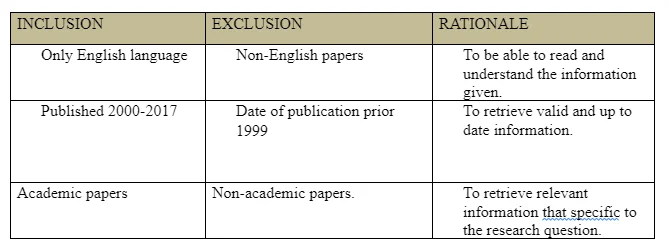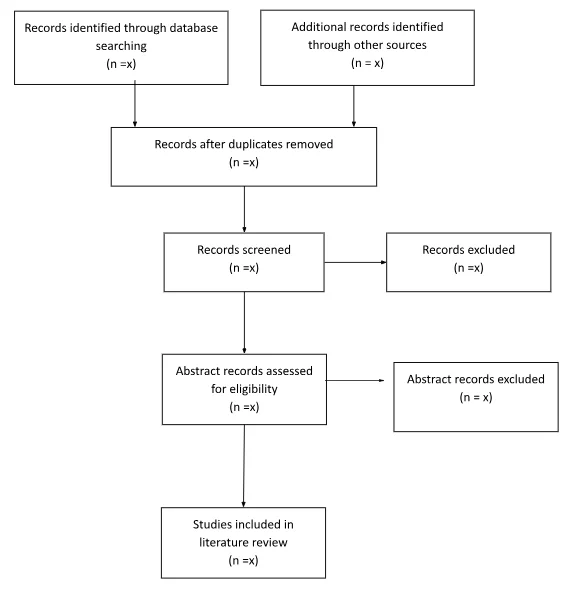Quality of Care in Nursing Homes
Introduction
The main aim of the dissertation is to identify different factors that improve the Improving Quality Care in Nursing. Therefore the study will begin by explaining the concepts of quality care and nursing home. Here, there will be a detailed definition of quality of care as well as what a nursing home is. Next, the paper will highlight the historical background of quality of care, as well as why nursing homes should adopt quality care. Furthermore, the introduction section will involve an overview of nursing homes in the UK, the average number of patients they admit and some of the quality challenges that have been documented in the existing literature. Afterwards, the paper will highlight various care models used in developing quality care such as the multidisciplinary chronic disease care in nursing (1), effectiveness, the culture of care and processes for improving Improving Quality Care in Nursing.
Research Methodology
Search Strategy
This section will highlight the techniques and strategies used in identifying and selecting the literature material for review. This, the search strategy section will be as detailed as possible. For instance, there will be a detailed demonstration of the systematic nature of the literature search process. Here, the researcher will highlight how the number of literature materials expected to be included in the study and a justification of why the number is appropriate. Besides, there will be a detailed narration of the processes included in selecting the studies from online databases such as Proquest, EBSCO and MEDLINE. There will be a justification of why these databases are chosen among several others.

One of the most important aspects of the search strategy that will have to be highlighted will be the inclusion/exclusion criteria. Here, the researcher will need to indicate which year of publications are considered and why, which study language is considered and why, as well as which type of journal articles will be included and why. Below is an example of inclusion /exclusion criteria that should be considered:

Meanwhile, the researcher will present a detailed chart of the studies and clinical guidelines retrieved from the search process, highlight their main objectives, authors, findings and other important details. Similarly, there will be a need for a Prisma chart illustrating the study selection process as illustrated in the example below.
PRISMA tool illustrating article search process

Literature Review
The literature review section will be the most important section of this paper. Here, the paper will analyze the study design population samples, data collection and analysis methods of each selected literature material, and their potential impact on the study findings. Furthermore, the researcher will be keen to identify how the findings of each study are relevant to the current study. Ideally, the search process will produce studies (a sample is attached in Appendix 1) of different methodologies. Therefore, the researcher will have to use different critical appraisal strategies that fit those methodologies. Therefore, it would be better to use the Critical Appraisal Skills Program (CASP) to guide the appraisal process. So, the following are some of the details that the researcher will consider when conducting the literature review for studies with specific methodologies.
Qualitative Studies
In the review of qualitative studies, the researcher will have to consider whether the authors have clearly stated their aims and objectives and whether qualitative research methodology was the best methodological approach for achieving those aims and objectives. Furthermore, while reviewing qualitative studies, the researcher will need to evaluate whether the research design was the most appropriate for achieving their objectives. The next item to be considered when reviewing qualitative research is whether the reviewed study used the correct participant recruitment approach for meeting their aims and objectives. This will involve identifying the study’s sampling method, the participant inclusion and exclusion criteria, as well as whether the participants had the right knowledge to help achieve the research objectives. When reviewing the qualitative study, the researcher will also need to consider whether the authors considered their roles and influence on the study outcomes (i.e. potential bias). Furthermore, attention will need to be given to the ethical consideration taken by the authors to ensure that the study findings were based on moral grounds. Meanwhile, other factors to consider when critically appraising qualitative studies include whether the authors rigorously analysed the data, whether they clearly stated the study findings and whether they came up with valuable results that are applicable to the current study.
Randomized Control Trials
Here, the literature review will consider the same items that were considered when analysing qualitative studies. However, there will be additional items to be considered. For instance, the researcher will evaluate whether the researchers effectively randomized the assignment of patients to the respective trial groups. Regardless of the methodologies of the studies reviewed, the most important consideration to be made during the literature review will be the aims and objectives of the studies. Here, the paper will have to consider whether there is a clear statement of the research aims and whether the studies ultimately achieve their aims. This will be part of the process of ascertaining the validity and reliability of the study findings. Furthermore, the literature review process will highlight how each study finding relates to or integrates with the aims of the current study. So, the reviewer will have to ascertain whether the reviewed studies aimed to identify the strategies for improving the quality of nursing homes and whether the highlighted strategies are applicable in the current study. The findings section will be organized into themes representing specific strategies identified in the reviewed literature. Thus, for example, if the researcher finds that some of the strategies for improving Improving Quality Care in Nursing include the effectiveness of treatment, quality improvement, developing a culture of care and empowering the staff; then the study critically analyses these strategies to identify their advantages and limitations. After that, the researcher will take a stand on why the strategies are useful and give recommendations on how the strategies can be improved further. Meanwhile, the themes will be developed through a thorough and systematic approach that includes comparing and contrasting the findings of each study and identifying common themes emerging from the same. Each theme will then be discussed separately while highlighting the implication of each theme on the entire subject.

Conclusion and Recommendation
This section will give a recap of the entire study as well as the way forward based on the study findings. Therefore, the researcher will develop and present a detailed summary of the review findings; highlighting the major themes and how they emerge from the review. Here, the researcher will have to conduct a tight balancing act to avoid repeating the entire study findings while highlighting only the important details related to the research objectives. In short, the researcher will attempt to summarize how the entire study has met the set aim and objectives. After conducting the summary, the paper will highlight the implications of the study to practice and policy. Furthermore, the researcher will need to highlight the implications of the study to nursing education, while noting the specific areas that need further research. The last bit of the study will highlight the dissemination strategy for the study findings. Here, the researcher will identify and justify the most appropriate method for ensuring that targeted the study findings reach the targeted audience and create the intended impact on practice, policy and future research. The researcher will highlight the selected journal article where the study will be published, its target audience and a justification of why that journal article is the most appropriate. Meanwhile, the researcher will demonstrate how the message will be tailored to meet various audiences such as nurses, hospital managers and other practitioners.
Refrences
- Boorsma M, Fritjers DHM, Knol DL, et al. Effects of multidisciplinary integrated care on quality of care in residential care facilities for elderly people: a cluster randomized trial. CMAJ 2011;183:E724–32 [PMC free article] [PubMed] [Google Scholar]
- Federal–Provincial Working Party on Patient Classification. Report: types of care. Ottawa (ON): The Party; 1973 [Google Scholar]
- Fink HA, Taylor BC, Tacklind JW, et al. Treatment interventions in nursing home residents with urinary incontinence: a systematic review of randomized trials. Mayo Clin Proc 2008;83:1332–43 [PubMed] [Google Scholar]
- Simmons SF, Keeler E, Zhuo X, et al. Prevention of unintentional weight loss in nursing home residents: a controlled trial of feeding assistance. J Am Geriatr Soc 2008;56:1466–73 [PMC free article] [PubMed] [Google Scholar]
- Sales AE, Bostrom AM, Bucknall T, et al. The use of data for process and quality improvement in long-term care and home care: a systematic review of the literature. J Am Med Dir Assoc 2011; Feb. 15 [Epub ahead of print] [PubMed] [Google Scholar]
- Rahman AN, Schnelle JF. The nursing home culture-change movement: recent past, present, and future directions for research. Gerontologist 2008;48:142–8 [PubMed] [Google Scholar]
- Crotty M, Halbert J, Rowett D, et al. An outreach geriatric medication advisory service in residential aged care: a randomised controlled trial of case conferencing. Age Ageing 2004;33:612–7 [PubMed] [Google Scholar]
- Bishop CE, Weinberg DB, Leutz WM, Zincavage R, et al. Nursing assistants’ job commitment: effect of nursing home organizational factors and impact on resident well-being. Gerontologist 2008;48(Suppl 1):36–45 [PubMed] [Google Scholar]
- Mintzberg H. Managing the myths of health care: bridging the separations between care, cure, control, and community: Berrett- Koehler Publishers
- Parand A, Dopson S, Renz A, et al. The role of hospital managers in quality and patient safety: a systematic review. BMJ Open 2014;4:e005055
- Wiig S, Storm M, Aase K, et al. Investigating the use of patient involvement and patient experience in quality improvement in Norway: rhetoric or reality? BMC Health Serv Res 2013;13:206.
- Wiig S, Robert G, Anderson JE, et al. Applying different quality and safety models in healthcare improvement work: boundary objects and system thinking. Reliability Engineering & System Safety 2014;125:134–44
- Damschroder LJ, Aron DC, Keith RE, et al. Fostering implementation of health services research findings into practice: a consolidated framework for advancing implementation science
- Shekelle PG, Pronovost PJ, Wachter RM, et al. Advancing the science of patient safety
- Muszalik, M., Kornatowski, T., Zielińska-Więczkowska, H., Kędziora-Kornatowska, K., & Dijkstra, 2015. A Functional assessment of geriatric patients in regard to health-related quality of life (HRQoL). Clinical Interventions in Aging,
- Holden RJ, Scanlon MC, Patel NR, Kaushal R, Escoto KH, Brown RL, et al. A human factors framework and study of the effect of nursing workload on patient safety andemployee quality of working life. BMJ quality & safety 2011;20(1):15–24.
- Ball JE, Murrells T, Rafferty AM, Morrow E, Griffiths P. Care left undone’ during nursing shifts: associations with workload and perceived quality of care. BMJ quality & safety 2013;23:92–94.
- Meijer A, Van Campen C, Kerkstra A. A comparative study of the financing, provision and Improving Quality Care in Nursing. The approach of four European countries: Belgium, Denmark, Germany and the Netherlands. Journal of Advanced Nursing 2000;32(3):554–561. pmid:11012796
- Duffield C, Diers D, O'Brien-Pallas L, Aisbett C, Roche M, King M, et al. Nursing staffing, nursing workload, the work environment and patient outcomes. Applied Nursing Research 2011;24(4):244–255. pmid:20974086
- Havig AK, Skogstad A, Veenstra M, Romøren TI. Real teams and their effect on the Improving Quality Care in Nursing. BMC health services research 2013;13(1):499 510.
- 24/7 Customer Support
- 100% Customer Satisfaction
- No Privacy Violation
- Quick Services
- Subject Experts



